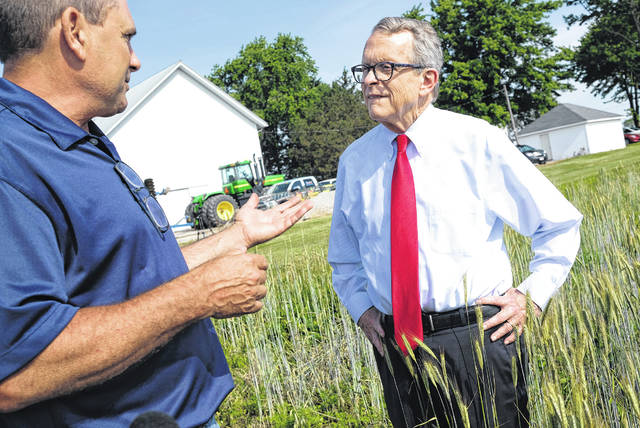
Ohio Gov. Mike DeWine spent Wednesday morning visiting a Perrysburg Township, Ohio farm and listening to farmers talk about the devastating effect of record-breaking rainfall.
“I saw for myself the disaster was as bad as it was described or worse,” DeWine said following the session. “This is a disaster of historic proportions. There have been some bad years, but there are tens of thousands of acres which will not be planted.”
Kris Swartz, who hosted the session at his farm, was pleased with the governor’s visit and praised him for listening and understanding the massive problems local farmers are facing.
“I like that the governor listened to the minor suggestions regarding policies that will help us survive,” Swartz said.
“He really understood the situation. He didn’t need an Agriculture 101 lesson, he knows you don’t plant crops in mud. It was really great.”
Heavy impact here
OSU Extension Agent Tony Nye pointed out in Saturday’s News Journal that, “the state is lagging the furthest behind in planting corn and soybeans compared to all states that plant the crops.
“From June 1, 2018, to May 31, 2019, average rainfall across Ohio totaled 52 inches, which is about 10 inches above the mean for that period in the last decade according to Aaron Wilson, climate specialist for Ohio State’s College of Food, Agricultural, and Environmental Sciences (CFAES).
“As a result of all this wet weather, only 50% of Ohio’s corn crop and 32% of its soybean crop was planted by June 9 according to information from the U.S. Department of Agriculture. By now, Ohio typically is 96% done with planting corn and 89% done with soybeans.”
DeWine sees soggy fields
Upon his arrival at the Perrysburg Township farm, the governor went on a tour with Swartz out to the soggy fields.
Upon his return, to the meeting in a Swartz barn, DeWine thanked everyone for attending and assured them that Ohio Department of Agriculture Secretary Dorothy Pelanda has been keeping him informed of the conditions.
He then opened up the floor to the farmers in attendance to share their stories and concerns. They were eager to have the governor’s ear.
“This is the worst weather we’ve ever seen. My dad is 81 and he’s never seen anything like this,” said Mark Drewes, a Hoytville-area farmer.
Drewes said that one of his concerns is getting enough corn to feed the cows for a neighboring dairy farm that he is contracted with to supply feed.
“This is the first time in my farming career that our backs are against the wall,” Drewes said.
He added that prevent planting insurance and other relief efforts may help.
“It doesn’t help to put feed into the mouth of those cows,” Drewes added.
Nathan Eckel, a Perrysburg-are farmer has both grain fields and livestock.
“We’re just in survival mode at this point. If we get through this year, it will be fine but what are we going to do next year?” he said.
Many farmers said that this is not a one-year situation. The ripple effects will linger for at least one or two more years. That is because ergonomically, there is a crop rotation which is followed to keep the soils at their peak and viable.
“Yes, we may make it to next year but it’s going to be painful,” Swartz said.
Other concerns that were raised:
• Having to deal with combating the weeds, which will thrive on the barren fields.
• Dealing with having to buy out contracted corn which is now not going to be planted.
• Having wheat fields planted last fall that are one-third failed, one-third dying in the field, and the one-third left questionable as to quality and may not be good.
• Questioning where there is any corn available and what will be its cost for those that need it.
• Stating the rules and regulations with collecting on prevent planning insurance are hampered if farmers end up harvesting their cover crops. With all the attention being focused on planting cover crops for this year, cover crop seed is now in limited supply.
• Asking if $3 billion being made available through federal funding will only be accessible if the area counties are declared disaster areas.
• Pointing out that this could be a breaking point for some smaller and marginal farms without backup reserve funds.
• Talking about crippling regulations, based on four-year historical statistics for crop insurances, for newer and younger farmers who do not have that background.
After hearing from the farmers, DeWine told them they can help by documenting their statistics and providing them to Swartz, who was volunteered to be the point main for data.
The governor also suggested writing letters to national representatives, such as U.S. Rep. Bob Latta, R-Bowling Green, and both Ohio senators.
Bob Short, president of the Ohio Federation of Soil and Water Conservation Districts and a Williams County farmer, is staying positive.
“Farmers are resilient. We always get through it, no matter what ‘it’ is. But this year will have a major ripple effect on many others,” he said.
As examples, he noted the fertilizer dealers, the seed companies, the livestock farmers, the co-ops and even the non-farmers.
“People are going to be hit hard if they have to buy an $8 box of corn flakes or hamburger gets to be the price of steak and steak gets to be the price of lobster, etc. There are going to be long-lasting effects for years to come,” Short said.


